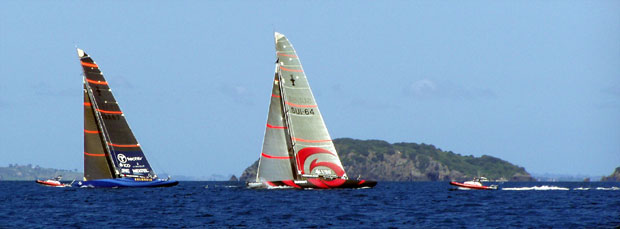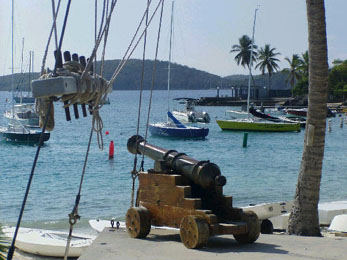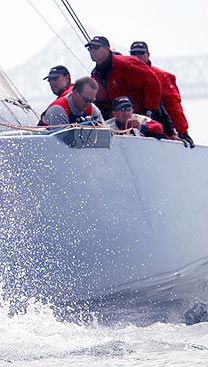CI: The nature of the Americaís Cup, where entire teams live abroad for long periods of time, requires some flexibility, if not sacrifice. How does one move to another continent for extended periods of time and keep family happy? Peter Holmberg: I think for some people itís complicated. For myself, itís ideal. I donít have any children at present, so for my wife and me, itís a treat! You get to go live in another country for a few years, the visas are all arranged, the work permits all arranged, the housing arranged. So there is plenty of time to live here in my home. An opportunity to go two, three, four years in Auckland was fantastic. To go to Spain for two to three years is wonderful. CI: With the pre-regattas scheduled from fall 2004 through 2007, is this a four-year campaign, or will there be periods for normal life during the quest to retain the Cup? PH: Without being too specific but to give you a generalization, at some point Team Alinghi will go full-time in Valencia, roughly one year from now, I imagine. Prior to that the sailing team will have other commitments that we all will be doing. So we will do the pre-regattas in Marseille and Valencia. Iíll still keep my base here until the final move and I believe everybody will do the same. CI: Itís clearly healthy to do regattas like the Heineken or Antigua.
PH: Yes, a smart plan of Alinghi's. I was glad once I saw that their schedule was this way. The Americaís Cup gets quite intense, the training Ö two, three years, thatís a long time. Think of any other sport that spends two to three years preparing for the big match. Burnout has got to be one of the biggest fears. It was smart of Alinghi to encourage everyone to take time off and have fun and fall in love with your sport again. CI: The back of the boat has two wheels, but only one driver. You have moved from one team flush with afterguard talent to another with the same ďgood problem.Ē Whatís your favorite position on the boat? PH: My strength is driving. Thatís what Iíve done all my life. I grew up single-handed sailing, so I drive my boat, and then I got into the match racing circuit as a professional and have been hired mostly as a driver. Thatís my forte. I do think itís healthy to cross-train and do some tactical and strategist work. With this program Iím a team player. Weíve got a lot of people and we donít know our roles yet. Itís smarter to be flexible. CI: Some teams have tried using two drivers Ė one for tactical boat-on-boat at the start, then handing off to another helmsman, or driving based on windward-leeward, the way Dennis Conner used to sail the downwind legs. Do you think this strategy has merit or causes confusion? PH: The teams that did that found it was the best way to take advantage of the strengths and weaknesses of their team. Iíll use Prada as an example. Francesco is a very talented helmsman, but match racing is a unique skill set. Itís the boxer in the ring, and some guys donít have that demeanor and skill set, but everything else they have. So, they smartly brought someone else in to fill that one weakness. If it works for them itís OK, so I think both ways work. CI: You are in a unique situation, having moved from Oracle 2003, now the Challenger of Record, to Alinghi, the defender. In fact, you may be the only person alive to drive both USA-76 and SUI-64. What led you to Team Alinghi? PH: I believe that an Americaís Cup project is a broad, diverse program thatís not just sports, itís very much management and organization. I finished the last campaign and set some very specific goals of what I wanted at the next stage in my life. If I was to do another Americaís Cup project, I wanted to be with certain individuals and organizations. I studied Alinghi closely. Last time they were the target, the benchmark for us, during a good part of the campaign, and I admired the emphasis on professional organization and their team-first attitude, the people there and skills there. So I came out of the last Cup and we all became free agents at the end of Oracle. The contract was finished, so I became free. I contacted one or two individuals I wanted to work with Ö One of them was Alinghi. CI: In the wake of their showing in 2003, some people mark Alinghi as the best sailing team in the world. Are there any difficulties in stepping into that environment?
PH: Itís a dream for any sailor, I believe. Some people ask why join a team thatís got Coutts there, that's got Schueman there? Youíre not going to get a job. Iíve got three years ahead of me sailing with the best sailors in the world, best sailors Iíve ever seen. What a wonderful opportunity. So any sportsman would enjoy the opportunity to get on a team made up of such remarkable sailors. CI: Oracle is also loaded with talent, including new guys theyíve gathered like Gavin Brady, John Kostecki, Ross Halcrow, Craig Monk, Robbie Naismith. Have the Defender and Challenger of Record already ďrun the table,Ē or will it be equally hard for either one of them to repeat? PH: Good question. There was obviously a lot of talk of this in the past when there were only those two teams growing and running at full pace. Over the last month or two I think weíve seen some serious activity with other teams, and the talent is there, you know. So, no, Iíd like to believe that Alinghi are going to have the awesome team and be strong. Oracle does have lots of talent, but I believe youíll see many other teams. Everybody saw what worked last time. Everybody sat down with their sheet of paper. I think fairly soon youíll see some other strong teams emerging. CI: Money plays a big part in professional sport. While most of the professional sailors are casting about, waiting for syndicates to obtain funding, you moved to the fully-funded defender. Could you comment on the personal security that provides?
PH: For me itís OK. You know, think of it as an independent contractor versus working at a company. Professional sailors are now lucky. The sport has grown to a point where you can make a living, so many people like myself have the option of choosing. I can remain an independent and accept jobs of short duration, or you have this Americaís Cup project that you commit to as an employee for two years. So itís one or the other, and each is OK. CI: From your experience with Oracle, what was the best thing from their camp? What was your biggest ďtake-awayĒ from the Oracle campaign? PH: I learned a great deal about the management side of campaigns and how important it is. Met some incredibly good sailors. Highly impressed with the New Zealanders Ė we had many of them on our team and I worked with many of them closely. Personally, from my upbringing and my style of operating, I found the Kiwis to be very good to work with. The testing and technology behind the Cup, I learned a great deal about that, and was fascinated by it.
Page 1 | Page 2 | >>Page 3: Alinghi and the Cup's future |
||||||||||||||
|
Photographs on this page copyright CupInfo, and Chuck Lantz, used with permission. please contact us: |



